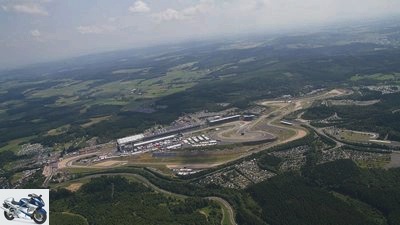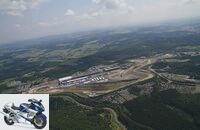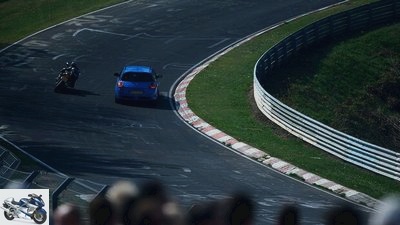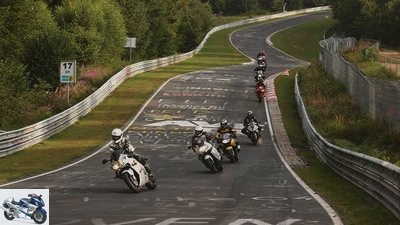Table of contents

Nurburgring
Sports & scene
Interview with Dr. Robertino Wild
Sport: Interview Dr. Robertino Wild
“I’m related to the Nurburgring”
In 2015 the Nurburgring is to be transferred from state to private hands. The designated owner Robertino Wild explains to MOTORRAD his plans, the reasons for the purchase and what motorcyclists can expect at the Ring in the future.
Eva Breutel
08/28/2014
What is your vision for the ring?
Wild: To fill it with more life, and that means: with more motorsport. We want to maintain or expand all classic types of events. What doesn’t belong on the Nurburgring is what others call a fair. She must leave.
Buy complete article

Sport: Interview Dr. Robertino Wild
“I’m related to the Nurburgring”
4 pages) as PDF
€ 2.00
Buy now
So the amusement park with roller coaster and large catering.
Wild: Yes. Building that there was a fallacy of managers who probably weren’t really interested in motorsport and were bored with racing. A roller coaster or a shopping mile seemed like an interesting change for them. But that doesn’t make sense for a motorsport fan. He wants to be close to his sport at the ring and not ride a roller coaster or go to a starred restaurant. He simply doesn’t have the time for that, he prefers to eat a currywurst.
What do you do with the amusement park?
Wild: We will dismantle the roller coaster and sell it when we have the necessary permits. And I would also like to tear down the Eifel village “Green Hell” with its large-scale gastronomy, it is not accepted by visitors all year round, but only at major events. The demolition still has to be approved. If that works, another business park will be built there.
Like in Meuspath near the Nordschleife, where part of your Capricorn company is also based?
Wild: Yes, we have a composite production facility there with around 100 employees. The Meuspath business park is a huge success, we have seen it grow, today more than 400 employees work there. If the Eifel village disappears, a similar area could arise there. We already have very specific inquiries from triple A companies. Unfortunately, I am not allowed to tell you who it is, but there are companies who are already asking when they can build there. Basically, I want to bring more industry to the ring.
Why did you even buy the Nurburgring? Your Capricorn company is doing well, you shouldn’t have tied a difficult terrain like the ring to your leg.
Wild: I’m related to the ring and have a very close relationship with the track. Since the early 1980s, when I just had my driver’s license, I have regularly ridden my motorcycle on the Nordschleife, especially my Guzzi Le Mans 1. Later I did driving tests there for Hein Gericke, who, like me, comes from Dusseldorf . In 2000 I opened a driving test center for automobile manufacturers in Meuspath, and composite production was added in 2009.
The reason for buying is only in your personal relationship with the ring?
Wild: No, of course not. After all, I’m a businessman. We looked out the window and saw: the neighbor is selling his property. We were interested in that, we obtained the tender documents, which tell an expert which sales price seems appropriate. I am not so good at it myself, but some of my employees are. Then we started to do the math and found: If the ring goes for this money, it’s good business. We come from motorsport, we understand something about it, that’s why we dare to do it. I myself have had a wide variety of roles in racing teams, from mechanic to driver to team boss. And above all, I’ve always rented racetracks, I know how they should work.

Nurburgring
Motorcycles and cars together on the Nordschleife – that should no longer exist from 2015.
There was not only approval of the purchase, but also harsh criticism. How do you deal with that?
Wild: It was clear that the sale of the Nurburgring would make huge waves. Likewise, that it would set criticism, which hit me in part because it went below the belt. But there was and is a lot of approval. In the meantime we have convinced 90 percent of the people on the Ring, simply with results: The two hotels at the Nurburgring have around 40 percent growth in turnover, which puts them at the top in Germany; that’s not what we say, but the industry association Dehoga. And the hotels only generate revenue when the Nurburgring has visitors. So we are making great strides.
For motorcyclists, the tourist trips on the Nordschleife and the Grand Prix track are particularly important. How does it go on??
Wild: Of course they still exist. But we want to separate cars and motorcycles, together it’s too dangerous. It’s not clear to me anyway why that was the case up to now, it doesn’t exist on any other racetrack. We have already completely banned buses on the route, and the first days of pure motorcycle riding have already taken place.
How is that supposed to work organisationally?
Wild: Ideally, from the 2015 season there will be pure motorcycle and car sessions, staggered either by days, but maybe also by hours. To do this, of course, we need a functioning information system, preferably on the Internet, so that a motorcyclist doesn’t come when only cars are allowed on the track. The Nordschleife in particular is an icon for motorcyclists from all over Europe, many of them take on the greatest exertion to drive a few laps here.
They want to strengthen the industrial pool and thus the test drives on the Nordschleife and Grand Prix track. Don’t get in the way of the tourist trips?
Wild: Not at all, it’s symbiotic. The test drivers in the industry do this professionally, they only drive during the week from 9 a.m. to 5 p.m. at the latest. The tourist drivers come to the train in the evening and at the weekend, just as before. In the evening, the last entry is currently at 7.15 p.m., we even want to try to extend it to 7.30 p.m..
At the moment, a round of the Nordschleife costs 27 euros. It stays that way?
Wild: We are considering a dynamic price system, similar to that in the cinema. On weekdays, on some afternoons, nobody is on the track, on weekends you often have to wait up to an hour before you can drive in. That is why we would like to offer lower prices during the week and higher prices at the weekend. We hope that this will rectify the situation.
Various providers offer motorcycle training, especially on the Nordschleife. Will there be in the future??
Wild: Sure. However, the prices will not fall, I can tell you that now, because we need a better security concept, especially as a private provider. We want the same safety package with marshals, emergency doctors and ambulances for all training sessions. For the customer of a training course and also for the provider, this is a costly investment because he pays for something that he would prefer not to use. But there is no getting around security.
And if a provider doesn’t want that?
Wild: Then we’ll have to part with him. The Nurburgring is a premium product, a race track that is unique in the world. As the operator, we have to offer a premium service, but we also expect our tenants to be highly professional.
What about motorcycle events like world championship races?
Wild: The topic is totally wasted at the Nurburgring, and you have to consider what the causes are. The Grand Prix course is certainly not ideal for motorcycle races. After the accidents on the Nordschleife, especially that of Niki Lauda in 1976, it was built in such a way that nothing happens anymore, that is to say: with huge fall areas and stands that are very far away from the action. That’s not ideal for motorcycle races, the fans want to be as close to the track as possible. Public events for motorcycles therefore have to be started with new ideas. This is an important topic for us, but I don’t yet know exactly what it will look like.

Jahn
The tourist trips are divided into sessions for two- and four-wheelers.
We talked about the industry and the tourist trips. What else is part of your business model??
Wild: As I said at the beginning: Motorsport fans come to the ring and we want to offer them the best. These are mostly car races at the moment, but this may not be that interesting to your readers.
Yes, yes, most motorcyclists are also interested in car racing.
Wild: We want top events, including, of course, Formula 1, which traditionally belongs to the Nurburgring. When the Ring got into trouble, a window opened up for Hockenheim, and they took advantage of this gap. Hockenheim and the Nurburgring can certainly complement each other, but we are also competitors. We have already brought the WTCC World Touring Car Championship back to the ring, and another world championship race will be held on the Nordschleife! In 2015 there will also be the WEC endurance world championship, at the same time a 1000 kilometer race on the Nordschleife. So it’s going on.
Is it that easy for you to convince the organizers and the automotive umbrella organization FIA of your Nurburgring concept??
Wild: I have a very good network. Capricorn is one of the leading suppliers in the motorsport sector, we are known to every German team boss, as well as to the FIA and Bernie Ecclestone. To bring attractive motorsport events to the ring, it definitely helps if you have Ecclestone’s phone number in your pocket and don’t have to call information.
There were also rumors of plans for a university. Is that correct?
Wild: Yes. The German auto industry is a world leader, but there are no people who are familiar with racing. The teams need people who already know how a pit stop works and don’t have to learn it first. Therefore, there will be two courses on the subject of sports event management for the first time in summer 2015. The aim is to offer a master’s degree for engineers with a bachelor’s degree from the 2015/2016 winter semester, which qualifies them to work in a racing team. Another step are dual courses of study for trainees from the Meuspath industrial park.
Finally, a personal question: You are a medical professional, how did you get into racing??
Wild: (Laughs) It’s more like the other way around, I’ve never worked as a doctor. That’s why I’ve always worked on cars and motorcycles and also did so during my studies. In 1984 I founded my company, then as a hobby company under a different name. It only became Capricorn when we had more and more employees, today that’s 350. I wanted a heraldic animal, but everything that crawls and flies was already occupied, except for the ibex, and that’s how we came up with Capricorn. I think the ibex is a good symbol for a development company like ours: the ibex is lonely, lives alone at great heights and has to endure long winters. This also makes it a perfect match for the Nurburgring.
Dr. Wild, thank you for talking to us. All the best for you and the Nurburgring.
The ring sale: the background

Intoxication
Up until 1980 there were also motorcycle world championship races on the Nordschleife, here the start of the 250cc class in April 1972. Bad luck for the drivers back then: it snowed in between.
The history
The Nurburgring was opened in 1927 as the “First German Mountain Race and Test Track”, financed by taxpayers’ money. The Eifel seemed particularly suitable as a location for the state-owned builders, on the one hand because of the many inclines and declines on the course, on the other hand it was hoped an economic upswing for the structurally weak region. The route was 28.3 kilometers long and consisted of a north and south loop. The German Grand Prix for motorcycles already took place in the opening year. Right from the start, so-called tourist drivers could use the course in the evening or on race-free weekends for a fee with their cars and motorcycles. The last Formula 1 race took place on the Nordschleife in 1976, the motorcycles stayed there until 1980 and switched to the newly built GP circuit from 1984 onwards. However, the legend of the Nurburgring is based solely on the 20.8-kilometer-long Nordschleife, which is known by professionals and amateurs as the world’s most demanding race track. The racing driver Jackie Stewart gave her the name “Green Hell” with respect and awe..
“Nurburgring 2009” and bankruptcy
The gigantic “Nurburgring 2009” project was intended to turn the ring into a “world of experience”, including a shopping center, multi-purpose hall, cinema, roller coaster and the replica Eifel village “Green Hell” with several restaurants and a disco. But the project, which was financed with at least 330 million euros in taxpayers’ money, turned out to be completely oversized. The Eifel village degenerated into a ghost town and soon showed numerous construction defects, the roller coaster only ran for a total of four days due to technical problems. Because many tenants finally stopped paying, the state-owned Nurburgring GmbH had to file for bankruptcy in July 2012. From then on, the insolvency administrators were looking for a buyer.
The buyer Capricorn
In March 2014, the newly founded “Capricorn Nurburgringbesitz GmbH” was awarded the contract. Robertino Wild’s company Capricorn from Dusseldorf has a 67 percent stake in this operating company and GetSpeed from Meuspath holds a 33 percent stake. Capricorn is a well-known motorsport supplier that builds and develops high quality engine parts. Around 100 of the company’s 350 employees are already working at the Nurburgring, namely in composite production, which develops aramid, carbon and glass fiber composites in the Meuspath business park. GetSpeed is a company dedicated to supporting sports and racing drivers; the service ranges from vehicle tuning to driver coaching. The purchase price for the ring is 77 million euros; the takeover by the designated new owners is to take place on January 1, 2015.
The opponents
Several critics of the sale have lodged complaints with the EU, including the losing bidder NeXovation from the USA and the “Yes to the Nurburgring” association around the former ADAC President Otto Flimm. He made it clear on the club’s homepage that they had nothing against the buyer Capricorn, but that they had “doubts about the EU-compliant sale” of the Nurburgring. Flimm and his association are fundamentally questioning the sale to a private investor and are in favor of a “common good” solution – such as a foundation supported by the German auto industry. Other critics say that the ring is worth a lot more than the new operating company pays, or that it is not big and stable enough to carry the necessary investments. The motor journalist Wilhelm Hahne comments on the sale on his online portal in an extremely critical and sometimes even polemical manner www.motor-kritik.de. Hahnes anger is directed primarily against the Rhineland-Palatinate state government. Not without reason: because of an article about the dubious financing of the “Nurburgring 2009” project, he was the target of a house search in 2009.
EU decision
The European Union Competition Commission will have the last word on the Nurburgring sale. It came on the scene because the state of Rhineland-Palatinate had not registered its aid for the ring with the EU, contrary to the European rules of the game. It is now checked whether the aid was legitimate and whether the subsequent sales process was EU-compliant, ie “open, transparent and non-discriminatory”. In the event that the commission assesses both negatively, Capricorn Nurburgringbesitz GmbH has the right to withdraw from the purchase contract. Then the scramble for the ring would start all over again.
Sports driver course motorcycle training Nurburgring GP course 2014
Related articles
-
Interview with HJC company founder Wan Kee Hong
Yamaha Sports & scene Interview with HJC company founder Wan Kee Hong Interview with HJC company founder Wan Kee Hong “Koreans are extremely innovative…
-
2snap 37 pictures 2Snap 1/37 Casey Stoner joined MotoGP in the 2006 season. At that time, machines with 990 cubic meters were still used. The Australian…
-
DSF Sports & scene Interview with Alex Hofmann Interview with Alex Hofmann “Biaggi has no idea.” Content of Ex-MotoGP rider Alex “The Hoff” As a…
-
wolf 20th pictures Stefan Wolf 1/20 Interview with Peter Maffay. manufacturer 2/20 “The 9th tone – thoughts of a driven person” (as a paperback 12.99…
-
KTM motorcycles Interview with Stefan Pierer Interview with Stefan Pierer KTM presents a car next year In an interview with MOTORRAD employee Alan…
-
Interview with world rally champion Matthias Walkner
Sports & scene Interview with world rally champion Matthias Walkner Interview with world rally champion Matthias Walkner “The Dakar is in a different…
-
Interview with ADAC Motorsport President Hermann Tomczyk
ADAC Sports & scene Motorsport Interview with ADAC Motorsport President Hermann Tomczyk Interview with ADAC Motorsport President Tomczyk “Platform for…
-
Interview Alpinestars CEO Mazzarolo
Alpinestars Sports & scene Interview Alpinestars CEO Mazzarolo Alpinestars CEO Gabriele Mazzarolo in an interview with MOTORRAD “As safe on a motorcycle…
-
ZepGori 17th pictures Michael Orth 1/17 Machine 11: based on Le Mans 3, 950 cm3, 82 hp, weight 184 kg. Michael Orth 2/17 Finished conversions are…
-
Interview with actor George Clooney
Rousseau Sports & scene Interview with actor George Clooney Interview with actor George Clooney He loves beer and motorcycles as much as women Hello…